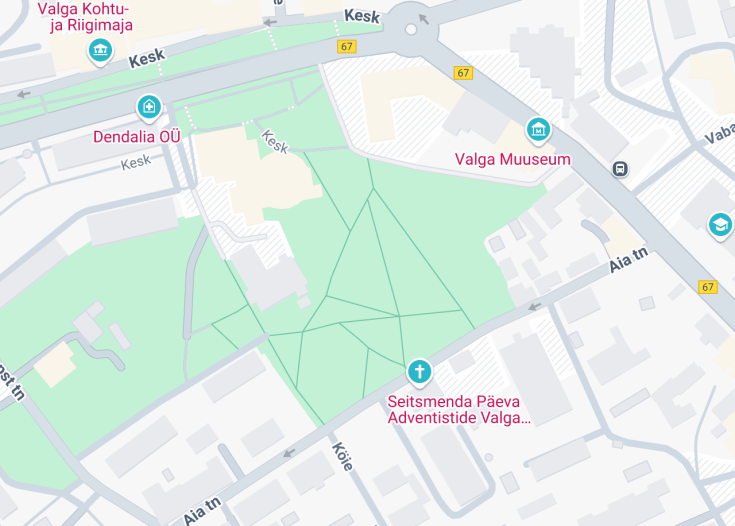Additionally, the park hosts various cultural events and exhibitions that celebrate the arts and history of Valga, providing visitors with a deeper connection to the community. Whether you’re interested in art, history, or simply looking for a peaceful spot to relax, Säde Park and the Statue of Nipernaadi offer something for everyone. The harmonious blend of natural scenery and artistic expression makes this destination a must-visit on your journey through Estonia.
Location
Nestled near the heart of Valga, Säde Park is conveniently situated close to major landmarks such as the Valga Central Library and the Valga City Museum, making it an easily accessible destination for tourists exploring the city.
Address
Aia tn 13, Valga, 68203 Valga maakond
Visiting Information
Säde Park welcomes visitors throughout the year, offering a peaceful retreat in a public park setting. There are no strict closing times, allowing you to enjoy the park at your own pace. For the best experience, plan your visit during the early morning or late afternoon when the light enhances the beauty of the surroundings.
How to Reach the Destination
Getting to Säde Park and the Statue of Nipernaadi in Valga is straightforward with multiple transportation options available:
Car
Säde Park is easily accessible by car. There is ample parking available adjacent to the park for a nominal fee, as well as several public parking lots nearby for convenience.
| Route |
Distance |
Travel time |
| From Valga Central Station |
1 mile (1.6 km) |
5 minutes |
| From Valga Bus Terminal |
1.2 miles (1.9 km) |
7 minutes |
| From Valga City Museum |
0.5 miles (0.8 km) |
3 minutes |
Public Transport
Public buses frequently run from Valga Central Station directly to Säde Park. The journey typically takes around 10 minutes, providing a convenient and eco-friendly way to reach the destination. Tickets can be purchased at the station or via mobile apps.
| Route |
Distance |
Travel time |
| From Valga Central Station |
1 mile (1.6 km) |
10 minutes |
| From University of Valga |
0.8 miles (1.3 km) |
8 minutes |
| From Valga Art Gallery |
0.6 miles (1 km) |
6 minutes |
Nearby Attractions
Enhance your visit by exploring these nearby points of interest:
- Valga Central Station – 1 mile (1.6 km)
- Valga City Museum – 0.5 miles (0.8 km)
- Valga Central Library – 0.7 miles (1.1 km)
- Valga Art Gallery – 0.6 miles (1 km)
- Old Town Square – 1.2 miles (1.9 km)
- Harmony Park – 1.5 miles (2.4 km)
- River Walk Path – 0.9 miles (1.4 km)
- Valga Botanical Garden – 2 miles (3.2 km)
- Historical Fort – 2.3 miles (3.7 km)
- Valga Sports Complex – 1.8 miles (2.9 km)
- Local Artisan Market – 1.3 miles (2.1 km)
- Valga Theater – 1.4 miles (2.3 km)
Common Questions
What is the historical significance of Säde Park in Valga, Estonia?
Säde Park, located in Valga, Estonia, holds substantial historical importance as a central public space that has evolved alongside the city itself. Established in the early 20th century, the park has been a focal point for community gatherings, cultural events, and social interactions. Over the decades, Säde Park has witnessed various historical milestones, including periods of reconstruction after wars and serving as a venue for public celebrations during Estonia’s journey to independence. The park’s enduring presence reflects the resilience and cultural heritage of Valga, making it not only a recreational area but also a symbol of the city’s historical narrative.
What artistic elements are featured in the Statue of Nipernaadi in Säde Park?
The Statue of Nipernaadi, prominently situated in Säde Park, is a masterpiece that encapsulates several artistic elements: 1. Sculptural Design: – Depicts the character Nipernaadi from Estonian literature, symbolizing freedom and wanderlust. – Crafted from bronze, providing durability and a timeless aesthetic. 2. Symbolism: – Represents the spirit of exploration and the quest for identity. – The figure’s posture suggests movement, aligning with the narrative of the literary work. 3. Integration with the Environment: – Positioned strategically within Säde Park to complement the natural surroundings. – Base adorned with inscriptions and motifs that enhance the storytelling aspect. 4. Lighting and Ambiance: – Equipped with subtle lighting to highlight details during evening hours. – Creates an inviting atmosphere for visitors to engage with the art. Overall, the statue serves as both a cultural landmark and a piece of public art that enriches the aesthetic appeal of Säde Park.
Are there any notable events in Säde Park related to the Statue of Nipernaadi?
Yes, Säde Park hosts several notable events that celebrate the Statue of Nipernaadi and its cultural significance: 1. Annual Literary Festivals: – Featuring readings and discussions about the works of the author who inspired Nipernaadi. – Activities include storytelling sessions and poetry recitals. 2. Art Exhibitions: – Temporary installations and exhibitions by local artists inspired by the statue. – Workshops and interactive art projects for visitors. 3. Cultural Performances: – Live performances such as theater, music concerts, and dance shows near the statue. – Themed events that align with the narrative of Nipernaadi’s adventures. 4. Community Gatherings: – Celebrations during national holidays that incorporate the statue as a centerpiece. – Educational tours and guided walks focusing on the park’s history and artistry. These events not only enhance the visitor experience but also reinforce the statue’s role as a cultural symbol within Valga.
What flora and fauna can be found in Säde Park surrounding the Statue of Nipernaadi?
Säde Park boasts a diverse array of flora and fauna that contribute to its serene environment around the Statue of Nipernaadi: Flora: – Trees: – *Tilia* (Linden trees) providing shade and aesthetic appeal. – *Betula* (Birch trees) adding a graceful, slender appearance to the landscape. – Flowering Plants: – Seasonal blooms such as tulips, daffodils, and roses enhancing color diversity. – Native shrubs and perennial flowers that attract pollinators. Fauna: – Birds: – Common species include sparrows, blue tits, and blackbirds. – Seasonal visitors like swallows and woodpeckers contributing to the park’s lively atmosphere. – Insects: – Butterflies and bees that play a crucial role in the ecosystem. – Small Mammals: – Squirrels and hedgehogs occasionally spotted within the park. The harmonious coexistence of plant and animal life not only enriches the visual experience but also supports biodiversity, making Säde Park a vibrant natural habitat.
How does the Statue of Nipernaadi reflect Estonian culture and literature?
The Statue of Nipernaadi is a profound reflection of Estonian culture and literature, embodying several key aspects: 1. Literary Connection: – Represents the protagonist from the renowned Estonian novel “Nipernaadi” by August Gailit. – Symbolizes themes of adventure, freedom, and the human spirit prevalent in Estonian literature. 2. Cultural Symbolism: – Depicts traditional Estonian attire and aesthetics, showcasing national identity. – Serves as a tribute to Estonia’s literary heritage and the influence of storytelling on cultural consciousness. 3. Artistic Expression: – Combines elements of realism and romanticism, common in Estonian artistic traditions. – The statue’s design reflects local craftsmanship and artistic values. 4. Community Identity: – Acts as a landmark that fosters a sense of pride and connection among residents. – Encourages the celebration and preservation of Estonian literary contributions. Overall, the Statue of Nipernaadi is not merely a decorative monument but a cultural emblem that encapsulates the essence of Estonia’s literary and artistic legacy.
What maintenance practices are employed to preserve Säde Park and the Statue of Nipernaadi?
Preserving Säde Park and the Statue of Nipernaadi involves comprehensive maintenance practices to ensure both natural and structural elements remain in optimal condition: 1. Landscape Management: – Regular gardening activities including pruning, weeding, and planting to maintain the park’s aesthetic. – Lawn care involving mowing, fertilization, and pest control to promote healthy vegetation. 2. Structural Maintenance: – Routine inspections of pathways, benches, and lighting fixtures to ensure safety and functionality. – Restoration efforts for the statue, including cleaning, applying protective coatings, and repairing any damage due to weathering or vandalism. 3. Environmental Sustainability: – Implementing eco-friendly practices such as using organic fertilizers and promoting native plant species. – Managing waste through recycling programs and maintaining cleanliness to enhance the park’s ecosystem. 4. Security Measures: – Installing surveillance cameras and regular patrols to deter vandalism and ensure the protection of park assets. – Engaging the community through volunteer programs to foster a sense of ownership and responsibility. These maintenance strategies are essential in preserving the beauty and integrity of Säde Park and the Statue of Nipernaadi, ensuring they remain cherished landmarks for future generations.
Are there any legends or folklore associated with the Statue of Nipernaadi in Säde Park?
Yes, the Statue of Nipernaadi in Säde Park is intertwined with local legends and folklore that enrich its cultural significance: 1. The Wanderer’s Legend: – Nipernaadi is believed to embody the spirit of an eternal wanderer, symbolizing the human desire for exploration and discovery. – Stories suggest that the statue comes alive under the full moon, embarking on secret journeys through the park. 2. Protective Spirits: – Folklore holds that Nipernaadi serves as a guardian of the park, protecting it from misfortune and ensuring harmony among visitors. – Legends narrate instances where the statue intervened to avert disasters or guide lost souls back to safety. 3. Romantic Tales: – Romantic folklore speaks of lovers meeting by the statue, believing that Nipernaadi blesses their unions. – Stories are shared about proposals and anniversaries celebrated in the park, invoking the statue’s presence as a witness to enduring love. 4. Cultural Festivals: – Local festivals incorporate mythical stories of Nipernaadi, re-enacting tales of heroism and adventure associated with the character. These legends and folklore not only add a mystical allure to the Statue of Nipernaadi but also strengthen the cultural tapestry of Säde Park, making it a place of both natural beauty and storytelling.
What architectural styles are evident in the design of Säde Park and its surroundings?
Säde Park and its surroundings showcase a blend of architectural styles that reflect the region’s history and aesthetic evolution: 1. Art Nouveau: – Ornate details and curved lines are prominent in some of the park’s surrounding buildings and structures. – Facades feature intricate floral motifs and decorative elements typical of the early 20th century Art Nouveau movement. 2. Classicism: – Symmetrical layouts and grandiose elements can be observed in certain sections of the park. – Benches, fountains, and statues incorporate classical design principles, emphasizing harmony and proportion. 3. Modernism: – Clean lines and functional design are evident in newer additions to the park, such as contemporary art installations and minimalist pathways. – Emphasis on simplicity and the use of modern materials contrast with the more ornate historical styles. 4. Traditional Estonian Architecture: – Local building techniques and materials influence the design of nearby structures, maintaining a cohesive cultural identity. – Decorative wooden elements and traditional roofing styles complement the natural surroundings of the park. The synthesis of these architectural styles creates a unique and visually appealing environment in Säde Park, enhancing its status as a cultural and historical landmark in Valga.
What role does the Statue of Nipernaadi play in local community events and activities?
The Statue of Nipernaadi serves as a central figure in numerous local community events and activities, reinforcing its role as a cultural symbol: 1. Centennial Celebrations: – Marking significant anniversaries related to the statue or the literary work it represents with parades and ceremonies. – Community members gather to honor the legacy and contribute to the statue’s upkeep. 2. Educational Programs: – Schools and educational institutions organize field trips and interactive sessions centered around the statue’s historical and cultural context. – Workshops and lectures about Estonian literature and art are frequently held in the vicinity. 3. Artistic Performances: – The statue provides a scenic backdrop for live performances, including theatrical plays, musical concerts, and dance recitals. – Annual art festivals often feature artists who create works inspired by Nipernaadi’s adventures. 4. Community Gatherings: – Social events such as picnics, outdoor yoga sessions, and community meetings take place near the statue, fostering a sense of unity. – Seasonal celebrations, like summer solstices and winter festivals, incorporate the statue into their festivities. Through these activities, the Statue of Nipernaadi actively engages the local community, fostering cultural enrichment and communal participation in Säde Park.
How has Säde Park evolved over the years since the installation of the Statue of Nipernaadi?
Since the installation of the Statue of Nipernaadi, Säde Park has undergone significant evolution, reflecting changes in societal needs and aesthetic preferences: 1. Expansion and Landscaping: – The park has expanded its boundaries to include more green spaces, walking paths, and recreational areas. – Enhanced landscaping with diverse plant species has increased biodiversity and visual appeal. 2. Infrastructure Development: – Introduction of modern amenities such as benches, lighting, and public restrooms to improve visitor comfort. – Installation of Wi-Fi hotspots and charging stations to cater to contemporary needs. 3. Cultural Enhancements: – Addition of art installations and sculptures that complement the Statue of Nipernaadi, creating a curated artistic environment. – Development of designated areas for performances and exhibitions, attracting cultural events. 4. Sustainability Initiatives: – Implementation of eco-friendly practices like rainwater harvesting, solar lighting, and waste reduction programs. – Promotion of sustainable mobility with bike racks and electric vehicle charging points. 5. Safety and Accessibility: – Upgraded security measures, including surveillance cameras and regular patrols, to ensure safety. – Improved accessibility features such as ramps, tactile paths, and clear signage for visitors with disabilities. Overall, Säde Park has transformed into a dynamic urban oasis that honors its historical roots while adapting to the modern demands of the community.
What are the best times of the year to visit Säde Park and the Statue of Nipernaadi?
Visiting Säde Park and the Statue of Nipernaadi can be a delightful experience year-round, each season offering unique attractions: 1. Spring (April to June): – Highlights: – Blossoming flowers and vibrant greenery create a picturesque setting. – Ideal for leisurely walks and photography. – Activities: – Bird watching as migratory species return. – Community gardening events and outdoor art exhibitions. 2. Summer (July to August): – Highlights: – Warm weather perfect for picnics, sports, and outdoor concerts. – Extended daylight hours allow for evening strolls illuminated by park lighting. – Activities: – Festivals and cultural performances held near the statue. – Interactive workshops and family-friendly events. 3. Autumn (September to November): – Highlights: – Stunning fall foliage with hues of red, orange, and yellow. – Crisp air conducive to hiking and nature appreciation. – Activities: – Seasonal festivals celebrating harvest and local traditions. – Art fairs and outdoor exhibitions showcasing autumn themes. 4. Winter (December to March): – Highlights: – Snow-covered landscapes offering a serene and magical ambiance. – Opportunities for winter photography and peaceful walks. – Activities: – Holiday decorations and light displays around the statue. – Winter markets and indoor events in nearby facilities. Each season brings its own charm to Säde Park, making it a versatile destination for various interests and activities throughout the year.
Are there any guided tours or informational plaques about the Statue of Nipernaadi and Säde Park?
Yes, Säde Park offers guided tours and informational plaques to enhance visitors’ understanding and appreciation of the Statue of Nipernaadi and the park’s historical context: 1. Guided Tours: – Availability: – Conducted by local historians and knowledgeable guides during peak tourist seasons. – Available upon request for groups and educational institutions. – Content: – Detailed narratives about the statue’s creation, symbolism, and the literary background of Nipernaadi. – Insights into the park’s development, notable landmarks, and ecological aspects. 2. Informational Plaques: – Placement: – Strategically located near the Statue of Nipernaadi and key areas within the park. – Content: – Descriptive texts providing historical facts, artistic details, and cultural significance. – Maps and diagrams illustrating notable features and plant species present in the park. 3. Multilingual Resources: – Information available in multiple languages to accommodate international visitors. – Audio guides and mobile app integrations for a self-guided tour experience. 4. Educational Programs: – Collaborations with schools and universities to offer specialized tours focusing on literature, art, and environmental studies. – Interactive sessions and workshops conducted in conjunction with the guided tours. These resources ensure that visitors gain a comprehensive and engaging experience while exploring Säde Park and the Statue of Nipernaadi.
What impact has the Statue of Nipernaadi had on tourism in Valga, Estonia?
The Statue of Nipernaadi has significantly influenced tourism in Valga, Estonia, serving as a major attraction and contributing to the city’s appeal: 1. Increased Visitor Numbers: – The statue attracts literature enthusiasts, art aficionados, and general tourists, leading to a steady rise in visitor influx. – Special events and cultural festivals centered around the statue further boost tourist arrivals. 2. Economic Benefits: – Enhanced tourism has stimulated local businesses, including cafes, restaurants, and souvenir shops near Säde Park. – Employment opportunities have expanded in the hospitality and service sectors to accommodate the growing number of tourists. 3. Cultural Promotion: – The statue promotes Estonian literature and art, positioning Valga as a cultural hub. – Collaborative initiatives with cultural institutions and artists elevate the city’s cultural profile on national and international platforms. 4. Urban Development: – Investment in infrastructure around Säde Park, such as improved transportation links and beautification projects, has made Valga more accessible and attractive. – Enhanced public spaces encourage longer stays and repeat visits, fostering a vibrant community atmosphere. 5. Educational Tourism: – Academic and literary tours focused on the statue and its literary origins attract students and researchers. – Educational programs and workshops in the park engage younger audiences, fostering a deeper appreciation for cultural heritage. Overall, the Statue of Nipernaadi has been a catalyst for tourism growth in Valga, enriching the city’s cultural landscape and contributing to its economic and social vitality.
Can visitors interact with the Statue of Nipernaadi, and if so, how?
Yes, visitors can interact with the Statue of Nipernaadi in several engaging ways, enhancing their experience and connection with the monument: 1. Photo Opportunities: – The statue serves as a popular backdrop for photographs, allowing visitors to capture memorable moments. – Seasonal decorations and lighting arrangements provide varied scenic settings for photography. 2. Informational Engagement: – Interactive plaques and QR codes near the statue offer detailed information, enabling visitors to learn more about its history and significance. – Audio guides and mobile app features provide immersive narratives for self-guided exploration. 3. Artistic Expression: – Visitors are encouraged to leave artful contributions such as sketches or messages, fostering a sense of community. – Temporary installations or collaborative art projects sometimes take place around the statue. 4. Cultural Activities: – Participation in organized events like readings, performances, and reenactments that involve the statue. – Engaging in storytelling sessions that bring the legend of Nipernaadi to life. 5. Recreational Interaction: – Climbing on designated parts of the statue (where permitted) for a closer view and a unique perspective. – Utilizing the surrounding area for leisure activities such as picnics and relaxation while appreciating the sculpture. These interactive elements make the Statue of Nipernaadi not just a passive monument but an active participant in the visitor’s experience at Säde Park.
What conservation efforts are in place to ensure the longevity of the Statue of Nipernaadi?
To ensure the longevity and preservation of the Statue of Nipernaadi, several conservation efforts have been implemented: 1. Regular Maintenance: – Scheduled cleaning routines to remove dirt, pollution, and biological growth, preventing deterioration. – Inspection of structural integrity to identify and address any signs of wear or damage promptly. 2. Protective Coatings: – Application of anti-corrosive and weather-resistant coatings to shield the statue from environmental factors. – Use of specialized materials that allow the statue to breathe while providing protection against moisture and pollutants. 3. Environmental Control: – Installation of subtle barriers or landscaping elements to minimize direct exposure to harsh weather conditions. – Monitoring of surrounding vegetation to prevent root growth or overhanging branches from affecting the statue. 4. Security Measures: – Implementation of surveillance systems and regular patrols to deter vandalism and theft. – Use of discreet barriers during off-peak hours to protect the statue from accidental damage. 5. Restoration Projects: – Engagement of professional conservators for major restoration efforts when necessary, ensuring historical accuracy and preservation standards. – Documentation of the statue’s condition and any restoration work performed for future reference. 6. Public Awareness and Involvement: – Educational campaigns highlighting the statue’s importance, encouraging respectful interaction from visitors. – Volunteer programs that involve the community in upkeep and monitoring activities. These comprehensive conservation strategies are vital in maintaining the Statue of Nipernaadi’s aesthetic and structural integrity, securing its place as a cherished landmark in Säde Park for generations to come.
HelloMondo review

"A peaceful park with a charming statue; perfect for a quiet visit."
Is Säde Park and the Statue of Nipernaadi in Valga, Estonia Worth Visiting?
The Säde Park offers a serene escape with its well-maintained pathways and lush greenery, perfect for leisurely strolls. The Statue of Nipernaadi stands as a captivating centerpiece, reflecting the town’s cultural heritage. Visitors can enjoy the peaceful atmosphere and scenic views, making it an ideal spot for relaxation and photography. While Valga may not be a major tourist hub, these attractions provide unique local charm and tranquility that can enhance your travel experience.










